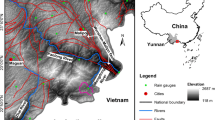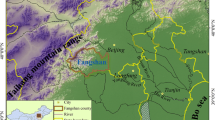Abstract
Climate change and rapid urban expansion can foster landslide disasters and cause severe damage in areas that are traditionally considered relatively safe from such hazards. In this regard, a recent event in Daoshi Town, China, is a good example that showcases the combined effect of extreme rainfall and urbanization in generating a first-time landslide disaster for a developing community. On 10 August 2019, Typhoon Lekima made its landing in Zhejiang Province, China. It generated a rainstorm close to Daoshi Town, inducing severe and unexpected damage from shallow landslides and debris flows (7 deaths, 25,560 affected and a direct economic loss of 1.5 hundred million dollars). In this region, similar rainfall has never been experienced before, and landslides have seldom been reported in the past. Field investigations and measurements were conducted to identify the landslide distributions, size characteristics, and mobility. A landslide inventory map, including 251 shallow landslides and 82 debris flows, was compiled to study the geological and topographical factors related to widespread failure. The results showed that shallow landslides and debris flows mainly occurred in the north-central part of the study area, in which the base was mainly composed of strongly weathered limestone. The elevation, mean slope, and slope aspect also contributed to the occurrence of landslides. In addition, 32.4% of the disasters were located close to buildings and roads, highlighting a relevant predisposing role played by human activity. This typhoon-bound rainstorm gave rise to a higher triggering condition than the normally required rainfall threshold in the study area. Under this circumstance, landslides were easily triggered and were able to transition into debris flows due to liquefaction. Field observations demonstrate that the erosion of slope toes caused by debris flows also facilitated the occurrence of other shallow landslides. A changing climatic setting is a never-before-experienced phenomenon for the study area. This research improves the understanding of landslide development in the area and prepares basic data and information for further studies and mitigation strategies.















Similar content being viewed by others
References
Abancó C, Bennett G, Matthews A et al (2021) The role of geomorphology, rainfall and soil moisture in the occurrence of landslides triggered by 2018 Typhoon Mangkhut in the Philippines. Nat Hazard Earth Sys 21:1531–1550. https://doi.org/10.5194/nhess-21-1531-2021
Abraham M, Satyam N, Kushal S et al (2020) Rainfall threshold estimation and landslide forecasting for Kalimpong. India Using SIGMA Model Water 12(4):1195. https://doi.org/10.3390/w12041195
Bernard T, Sinclair H, Gailleton B et al (2019) Lithological control on the post-orogenic topography and erosion history of the Pyrenees. Earth Planet Sc Lett 518:53–66. https://doi.org/10.1016/j.epsl.2019.04.034
Caine N (1980) The rainfall intensity-duration control of shallow landslides and debris flows. Geogr Ann A 62:23–27. https://doi.org/10.1080/04353676.1980.11879996
Carey J, Cosgrove B, Norton K et al (2021) Debris flow-slide initiation mechanisms in fill slopes, Wellington, New Zealand. Landslides 18:2061–2072. https://doi.org/10.1007/s10346-021-01624-6
Chen C (2016) Landslide and debris flow initiated characteristics after typhoon Morakot in Taiwan. Landslides 13(1):1–12. https://doi.org/10.1007/s10346-015-0654-6
Corominas J (1996) The angle of reach as a mobility index for small and large landslides. Can Geotech J 33(2):260–271. https://doi.org/10.1139/t96-005
Cruden D, Varnes D (1996) Landslide types and processes. In: Turner AK, Schuster RL (eds) Landslides investigation and mitigation. Transportation research board, US National Research Council. Special Report 247, Washington, DC, Chapter 3, pp. 36–75
Cui Y, Jiang Y, Guo C (2019) Investigation of the initiation of shallow failure in widely graded loose soil slopes considering interstitial flow and surface runoff. Landslides 16:815–828. https://doi.org/10.1007/s10346-018-01129-9
Dahlquist M, West A (2019) Initiation and runout of post-seismic debris flows: insights from the 2015 Gorkha earthquake. Geophys Res Lett 46(16):9658–9668. https://doi.org/10.1029/2019gl083548
Easterling D, Meehl G, Parmesan C et al (2000) Climate extremes: observations, modeling, and impacts. Science 289(5487):2068–2074. https://doi.org/10.1126/science.289.5487.2068
Eeckhaut M, Poesen J, Govers G et al (2007) Characteristics of the size distribution of recent and historical landslides in a populated hilly region. Earth Planet Sc Lett 256(3):588–603. https://doi.org/10.1016/j.epsl.2007.01.040
Eker R, Aydın A, Hübl J (2018) Unmanned aerial vehicle (UAV)-based monitoring of a landslide: Gallenzerkogel landslide (Ybbs-Lower Austria) case study. Environ Monit Assess 190:28. https://doi.org/10.1007/s10661-017-6402-8
Emberson R, Kirschbaum D, Stanley T (2021) Global connections between El Nino and landslide impacts. Nature Commun 12:2262. https://doi.org/10.1038/s41467-021-22398-4
Erin K, Coe J, Schulz W et al (2020) Mobility characteristics of debris slides and flows triggered by Hurricane Maria in Puerto Rico. Landslides 17:2795–2809. https://doi.org/10.1007/s10346-020-01445-z
Fan X, Leng X, Duan X (2015) Influence of topographical factors on movement distances of toe-type and turning-type landslides triggered by earthquake. Rock Soil Mech 36(5):1380–1388 (in Chinese)
Fogarty E, Elsner J, Jagger T et al (2006) Variations in typhoon landfalls over China. Adv Atmos Sci 23(5):665–677. https://doi.org/10.1007/s00376-006-0665-2
Guzzetti F, Malamud B, Turcotte D et al (2002) Power-law correlations of landslide areas in central Italy. Earth Planet Sc Lett 195(3–4):169–183. https://doi.org/10.1016/S0012-821X(01)00589-1
Guzzetti F, Mondini A, Cardinali M et al (2012) Landslide inventory maps: new tools for an old problem. Earth-Sci Rev 112(1–2):42–66. https://doi.org/10.1016/j.earscirev.2012.02.001
Hangzhou Municipal Bureau of Statistics (2017) Hangzhou statistical yearbook 2017. China Statistics Press, Beijing, p 2017
Hungr O, Leroueil S, Picarelli L (2014) The Varnes classification of landslide types, an update. Landslides 11(2):167–194. https://doi.org/10.1007/s10346-013-0436-y
Iverson R (2000) Landslide triggering by rain infiltration. Water Resour Res 36:1897–1910. https://doi.org/10.1029/2000WR900090
Kang X, Xu G, Yu Z et al (2020) Experimental investigation of the interaction between water and shear-zone materials of a bedding landslide in the Three Gorges Reservoir Area. China Bull Eng Geol Environ 79:4079–4092. https://doi.org/10.1007/s10064-020-01812-z
Kim J, Son K, Kim Y (2019) Assessing regional typhoon risk of disaster management by clustering typhoon paths. Environ Dev Sustain 21(5):2083–2096. https://doi.org/10.1007/s10668-018-0086-2
Koons P, Upton P, Barker A (2012) The influence of mechanical properties on the link between tectonic and topographic evolution. Geomorphology 137(1):168–180. https://doi.org/10.1016/j.geomorph.2010.11.012
Li Y, Ma C, Wang Y (2019) Landslides and debris flows caused by an extreme rainstorm on 21 July 2012 in mountains near Beijing. China Bull Eng Geol Environ 78(2):1265–1280. https://doi.org/10.1007/s10064-017-1187-0
Liang X, Gui L, Wang W et al (2021) Characterizing the development pattern of a colluvial landslide based on long-term monitoring in the Three Gorges Reservoir. Remote Sens 13(2):224. https://doi.org/10.3390/rs13020224
Liu X, Xie Z et al (2020) Analysis of rainstorm caused by super typhoon “Lekima” in Zhejiang Province of 2019. J Meteorol Sci 40(1):89–96 (in Chinese)
Lou X, Ma H, Huang X et al (2020) Analysis on the causes of extreme precipitation by typhoon “Lekima” in Zhejiang Province. J Meteorol Sci 40(1):78–88 (in Chinese)
Luna B, Remaître A, Van Asch T et al (2012) Analysis of debris flow behavior with a one dimensional run-out model incorporating entrainment. Eng Geol 128:63–75. https://doi.org/10.1016/j.enggeo.2011.04.007
Ma T, Li C, Lu Z et al (2015) Rainfall intensity-duration thresholds for the initiation of landslides in Zhejiang Province, China. Geomorphology 245:193–206. https://doi.org/10.1016/j.geomorph.2015.05.016
Masi E, Segoni S, Tofani V (2021) Root reinforcement in slope stability models: a review. Geosci 11(5):212. https://doi.org/10.3390/geosciences11050212
Mok H, Lui W, Lau D et al (2020) Reconstruction of track and simulation of storm surge associated with the calamitous typhoon affecting the Pearl River Estuary in September 1874. Clim past 19:1–40. https://doi.org/10.5194/cp-2019-36
Oouchi K, Yoshimura J, Yoshimura H et al (2006) Tropical cyclone climatology in a global-warming climate as simulated in a 20 km-mesh global atmospheric model: Frequency and wind intensity analyses. J Meteorol Soc Jpn 84(2):259–276. https://doi.org/10.2151/jmsj.84.259
Peng J, Zhuang J, Wang G et al (2018) Liquefaction of loess landslides as a consequence of irrigation. Q J Eng Geol Hydrogeol 51(3):330–337. https://doi.org/10.1144/qjegh2017-098
Piciullo L, Calvello M, Cepeda J (2018) Territorial Early Warning Systems for Rainfall-Induced Landslides Earth-Sci Rev 179:228–247. https://doi.org/10.1016/j.earscirev.2018.02.013
Ren J (1991) On the Geotectonics of Southern China. Acta Geologica Sinica (english Edition) 4(2):11–136. https://doi.org/10.1111/j.1755-6724.1991.mp4002001.x
Rosone M, Ziccarelli M, Ferrari A et al (2018) On the reactivation of a large landslide induced by rainfall in highly fissured clays. Eng Geol 235:20–38. https://doi.org/10.1016/j.enggeo.2018.01.016
Rosi A, Tofani V, Tanteri L et al (2018) The new landslide inventory of Tuscany (Italy) updated with PS-InSAR: geomorphological features and landslide distribution. Landslides 15:5–19. https://doi.org/10.1007/s10346-017-0861-4
Saito H, Korup O, Uchida T et al (2014) Rainfall conditions, typhoon frequency, and contemporary landslide erosion in Japan. Geology 42(11):999–1002. https://doi.org/10.1130/G35680.1
Seboong O, Lu N (2015) Slope stability analysis under unsaturated conditions: case studies of rainfall-induced failure of cut slopes. Eng Geol 184:96–103. https://doi.org/10.1016/j.enggeo.2014.11.007
Segoni S, Piciullo L, Gariano S (2018) A review of the recent literature on rainfall thresholds for landslide occurrence. Landslides 15:1483–1501. https://doi.org/10.1007/s10346-018-0966-4
Wang G, Suemine A, Furuya G et al (2005) Rainstorm-induced landslides at Kisawa village, Tokushima Prefecture, Japan, August 2004. landslides 2(3):235–242. https://doi.org/10.1007/s10346-005-0061-5
Webster P, Curry J, Liu J et al (2005) Changes in tropical cyclone number, duration, and intensity in a warming environment. Science 309(5742):1844–1846. https://doi.org/10.1126/science.1121564
Wu C, Chen S, Feng Z (2014a) Formation, failure, and consequences of the Xiaolin landslide dam, triggered by extreme rainfall from Typhoon Morakot. Taiwan Landslides 11:357–367. https://doi.org/10.1007/s10346-013-0394-4
Wu L, Wen Z, Huang R (2020) Tropical cyclones in a warming climate. Sci China Earth Sci 63(456–458). https://doi.org/10.1007/s11430-019-9574-4
Wu Y, Chen L, Cheng C (2014b) GIS-based landslide hazard predicting system and its real-time test during a typhoon, Zhejiang Province. Southeast China Eng Geol 175(12):9–21. https://doi.org/10.1016/j.enggeo.2014.03.005
Yang H, Yang T, Zhang S et al (2020) Rainfall-induced landslides and debris flows in Mengdong Town, Yunnan Province, China. Landslides 17:931–941. https://doi.org/10.1007/s10346-019-01336-y
Zheng Z, Pan L, Qian Y et al (2021) Evolution characteristics of extreme heavy precipitation in coast of Zhejiang Province caused by Typhoon Lekima. J Arid Meteorol 39(2):269–278 (in Chinese)
Acknowledgements
This research is supported by the National Natural Science Foundation of China (No. 42172318). We wish to thank the Lin’an Branch, Hangzhou Administration of Planning and Natural Resources, Zhejiang Institute of Geological Survey Institute and Zhejiang Institute of Geological and Mineral Exploration for their assistance. We also thank the reviewers for their suggestions that improved the quality of this paper.
Author information
Authors and Affiliations
Corresponding author
Ethics declarations
Conflict of interest
The authors declare no competing interests.
Supplementary information
Below is the link to the electronic supplementary material.
Rights and permissions
About this article
Cite this article
Liang, X., Segoni, S., Yin, K. et al. Characteristics of landslides and debris flows triggered by extreme rainfall in Daoshi Town during the 2019 Typhoon Lekima, Zhejiang Province, China. Landslides 19, 1735–1749 (2022). https://doi.org/10.1007/s10346-022-01889-5
Received:
Accepted:
Published:
Issue Date:
DOI: https://doi.org/10.1007/s10346-022-01889-5




